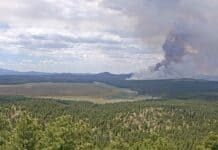The Sedona Community Youth Orchestra gave its free spring concert at the Sedona Performing Arts Center on May 5, under the direction of cofounders Kristina Beachell and Courtney Yeates. The concert featured both of the youth orchestra’s ensembles, the Prelude Orchestra composed of younger players, and the Concert Orchestra comprising the more advanced musicians, including a number of graduating high school seniors.
To supplement the cello section, which is a trifle sparse at the moment, Beachell and Yeates were switching off on Yeates’ cello throughout the performance. Yeates remarked that her co-director, who is a violinist, put in as much time as the kids did learning the cello parts. They were joined in that section by Sedona Charter School founder Bob Wentsch and distance runner Jerry Bloom, two of Yeates’ adult cello students.
“Some of us are young at heart,” Yeates joked, adding that it was “really cool” to have Wentsch performing as a student with and in front of the other students. Piano interludes between several of the orchestra’s pieces were supplied by Verde Valley School teacher Caleb Kulfan.
Violinist Anaya Ali opened the show with a short duet with Beachell on piano, the folk song “O Come, Little Children,” demonstrating good bow control for one so young. Both the Prelude and Concert groups subsequently joined forces for the daring selection of a portion of the first movement of Wolfgang Amadeus Mozart’s famously ominous Symphony No. 40. Beachell took a slow tempo, favoring the players, and it was fascinating to watch the young instrumentalists learning to respond to the conductor in action and adjust their dynamics as needed as they brought themselves together for a solid collected finish.
After the joint effort, it was the turn of the prelude orchestra to fly solo with an arrangement of one of Georg Philipp Telemann’s trio sonatas in A minor for string orchestra. They succeeded in capturing a bit of that baroque feel with a nice brisk tempo, keeping up with each other well. The Telemann was followed by a contemporary piece, Brian Balmages’ “Burst!” Under Yeates’ direction, this one came off like the soundtrack to a classic pirate film, which the young ensemble handled without any problem apart from a slight confusion in the middle. They were fully believable as a band of fiddlers on the deck of a galleon. If anything, the technique of the Prelude Orchestra’s members almost sounded better than that of the Concert Orchestra’s students.
Liam Friederici of the senior ensemble’s first violin section then gave a rendition of the opening movement from Antonio Vivaldi’s Violin Concerto No. 1 in G Major, with Kulfan joining him on piano. Although his bowing occasionally wavered, Friederici performed the trills beautifully, and his playing was strongest and most assured in the quicker passages and on the lower strings.
The Concert Orchestra took the stage next for an arrangement of Carlos Gardel’s “Por Una Cabeza,” in which bassist Brody Bodnicki did an admirable job of balancing the tendency of the violins to shrillness. While this selection did not make a particular splash, the next item on the program, the third movement from Franz Schubert’s Symphony No. 5, was far more effective. This work is sometimes known as “the symphony without trumpets and drums,” but even without those instruments, it retains Schubertian richness of conception that the ensemble successfully captured, getting the full effect of Schubert’s melodies across to the listeners and bringing out the changes of mood and volume involved. They showed much improved coordination in the piece from their practices, and more than that, they began to show that they were achieving a degree of fusion as a group, as their body language began to reflect that of Yeates at the podium as they played.
Beachell took over the baton again for a brisk arrangement of Edouard L a l o ’s “ S y m p h o n i e Espagnole.” Unlike the Schubert, this number did have timpani played by another of the SCYO’s young-at-heart members, and these gave it a quite dramatic, determined feel. The ensemble rose to the challenge posed by the spinning notes at the beginning of the work, in which the concertmaster’s fingering particularly stood out during an exposed solo passage.
The orchestra was joined for a few minutes by Sofia Wolfe, Melle Glatt, Phoebe Jones and Anisa Jaffe of the Sedona Dance Academy, who appeared as four swans in a selection from Peter Ilyich Tchaikovsky’s “Swan Lake.” Not only did the orchestra slowly improve throughout the excerpt, but with live music and live dance on stage together, a rare combination in Sedona, both musicians and dancers suddenly seemed far more real and vivid, potential shortcomings disappearing in an awareness of the immediacy of the creative effort that was taking place.
The star of the show was Concert Orchestra concertmaster Skyla Bird, who performed Jean-Baptiste Accolay’s Concerto No. 1 in A Minor accompanied by Kulfan on piano. Bird displayed the most impressively clear tone in the orchestra, performing the music emotively instead of just playing the written score, and turning potentially shrill notes into sweet ones through her control of her instrument. She demonstrated a true feel for the concerto, with good emphasis and little hesitation.
The junior and senior groups then rejoined one another for another Balmages piece, “Golden Grove,” for a big finish, in which they differentiated the layers of the music well, projecting a sense of anticipation as it started and bringing it to a neat conclusion.
